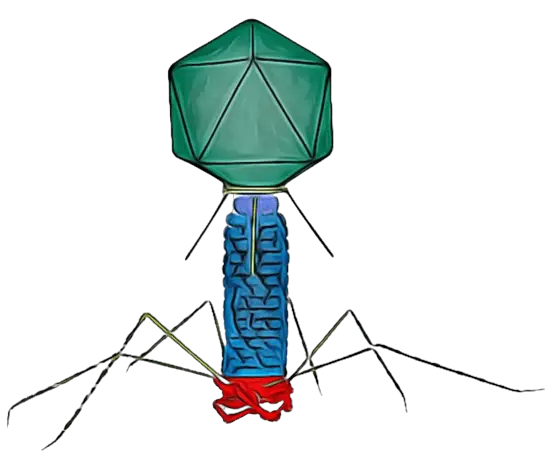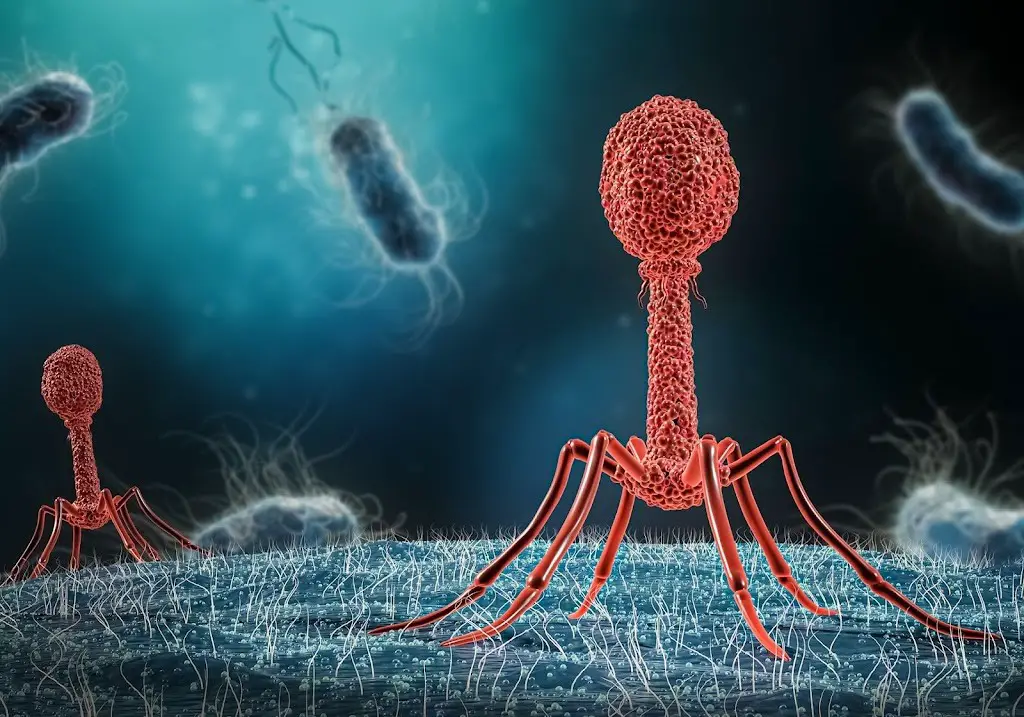What do bacteriophages look like?
In both academic and non-academic contexts around the world, a well-shaped particle with a clearly separated head, tail (neck, sheath, base plate, and pins), and tail fibers (very perfect body) has been used to depict bacteriophages. The shape that comes to mind when someone mentions bacteriophages is not the only shape that phages can be. T-4 bacteriophages are the source of the most well-known illustration morphology. Regardless of the fact that other bacteriophages have similar or nearly identical shapes (having slightly deviations like lacking some parts or having different body parts proportions), there are some with quite a peculiar shape. Other morphologies include “pipe/thread” like structures (e.g., Inoviridae), round (e.g., Cytoviridae), and icosahedral (e.g., Leviviridae); morphologies can be used to classify bacteriophages in the absence of other parts.
 |
| T4 bacteriophage. Photo by Omar CotsFernandez for The phage |
Bacteriophage classification by morphology (shapes)
The International Committee on Taxonomy of Viruses is in charge of virus (including phage) classification (ICTV). This body has proposed a morphology-based classification system. This version of classification is simpler than Bradley’s (which will be discussed later) and contains only four groups: polyhedral or cubic, filamentous or pleomorphic phages.
Classification of bacteriophages based on morphologies as per The International Committee on Taxonomy of Viruses (ICTV)
Tailed phages (equivalents to 96% of the phages discovered)
Classified as order Caudovirales, divided into three families: Myoviridae, Siphoviridae, and Podoviridae.
 |
| P1 bacteriophage. Photo by Omar CotsFernandez for The phage |
| Bacteriophage family | Example |
|---|---|
| Myoviridae phages- with icosahedral heads, contractile tails, double-stranded DNA (dsDNA) |
|
| Siphoviridae phages -with icosahedral heads, long and non-contractile tails, double-stranded DNA (dsDNA) |
|
| Podoviridae phages- have an icosahedral head, short tails, double-stranded DNA (dsDNA) |
|
Polyhedral or cubic phages
-classified into Microviridae, Corticoviridae, Tectiviridae, Leviviridae, and Cystoviridae.
| Bacteriophages family | Example |
|---|---|
| Microviridae phages- icosahedral head, virion size 27 nm, with 12 capsomers, single-stranded DNA (ssDNA) |
|
| Corticoviridae phages- no envelope, 63 nm in size, complex capsid, lipids, dsDNA |
|
| Tectiviridae phages- no envelope, 60 nm, flexible lipid vesicle, pseudo-tail, dsDNA |
|
| Leviviridae phages- no envelope, 23 nm, poliovirus-like, ssRNA |
|
| Cystoviridae phages-with enveloped, icosahedral head, 70-80 nm, lipids, dsRNA |
|
Filamentous phages
It-Made up of three families known as Inoviridae, Lipothrixviridae, and Rudiviridae.
| Bacteriophage family | Example |
|---|---|
| Inoviridae phages- no envelope, long flexible filament or short straight rods, ssDNA |
|
| Lipothrixviridae phages- enveloped, rod-shaped capsid, lipids, dsDNA |
|
| Rudiviridae phages- Straight uncoated rods, TMV-like, dsDNA |
|
Pleomorphic phages
Phages containing dsDNA are classified into several families: Plasmaviridae, Fuselloviridae, Guttaviridae, Bicaudaviridae, Ampullaviridae, and Globuloviridae.
| Bacteriophages family | Example |
|---|---|
| Plasmaviridae phages- enveloped, 80nm, with no capsid, lipids |
|
| Fuselloviridae phages- enveloped, tapered capsid with short spikes end, lipids. |
|
| Ampullaviridae phages- enveloped, bottle-shaped virion, 230 nm in length |
|
| Guttaviridae phages- droplet-shaped |
|
| Bicaudaviridae phages- Lemon-shaped virions, 120X 80 nm, long tails |
|
Classification of bacteriophages based on morphologies as described by Bradley (1967)
Type A: Bacteriophage with hexagonal head and tail with contractile sheath
These viruses have a “tadpole shape,” meaning they have a hexagonal head, a rigid tail with contractile sheath and tail fibers dsRNA, and T-even (T2, T4, T6) phages. Most of the phages are T-shaped.
 |
| Siphoviridae phage with a long non-contractile tail. Drawn by Omar Cots Fernandez for The Phage |
Type B: Bacteriophage with a hexagonal head and long, flexible tail
Unlike Type-A, these phages contain a hexagonal head, but they lack a contractile sheath. Its tail is flexible and may or may not have tail fiber, such as dsDNA phages, e.g., T1 and T5 phages.
Type C: Bacteriophage with a hexagonal head and short, non-contractile tail
Type C is characterized by a hexagonal head and a tail shorter than the head. The tail lacks contractile sheath and may or may not have tail fiber, such as dsDNA phages, e.g., T3 and T7.
Type D: Bacteriophage with only hexagonal head in symmetry with large capsomere on it
Type D contains a head made up of capsomers but lacks a tail, for example, ssDNA phages (e.g., φX174). The capsomeres are subunits of the capsid, an outer covering of protein that protects the genetic material.
Type E: Bacteriophage with a simple regular hexagonal head
This type consists of a head made up of small capsomers but contains no tail, for example, ssRNA phages (e.g., F2, MS2).
Type F: Bacteriophage with no head but with long flexible filament virion
These phages are named for their filamentous shape, a worm-like chain, about 6 nm in diameter and about 1000-2000 nm long.
Type G: No detectable capsid (This group was added later after Bradley’s original study publication)
This group has a lipid-containing envelope and has no detectable capsid, for example, a dsRNA phage, MV-L2.
This page is subjected to frequent updates.



Comments